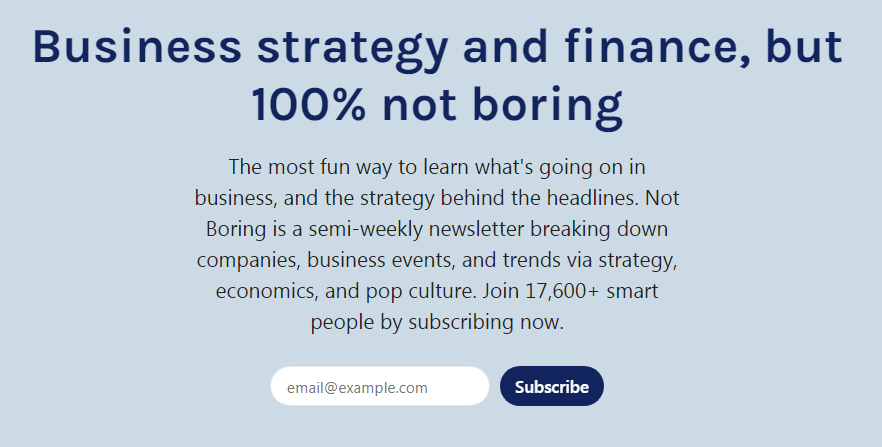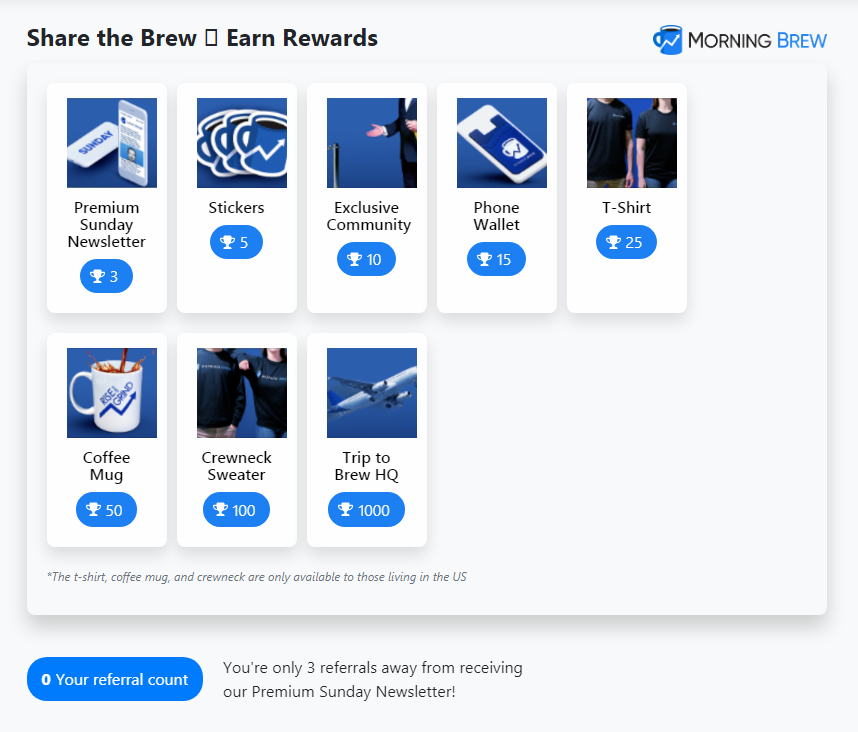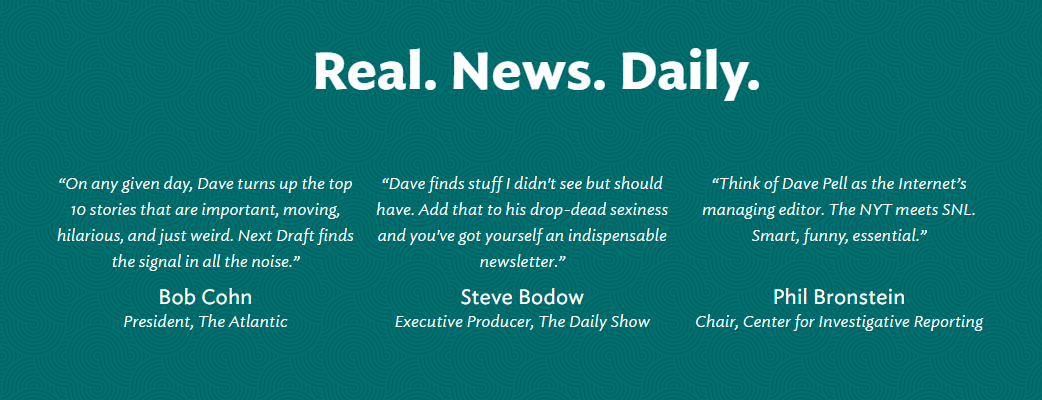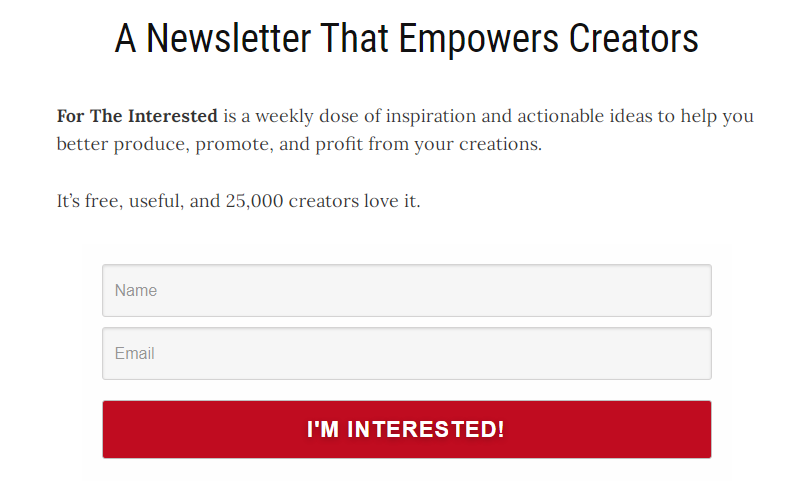Build your customer referral program without the dev time
Sign up for a free trial of GrowSurf to lower your customer acquisition costs, increase customer loyalty, and save gobs of time.
Launch Your ProgramIf you own a newsletter and you have loyal readers but you're failing to attract new subscribers, it might be time to add a newsletter referral program to the mix, and to work on your copy to make it more persuasive. According to Mention Me, referral marketing campaigns leverage the social connections and relationships that consumers have, transforming them into potent referral tools. The credibility gained from a personal recommendation often surpasses that of traditional advertising.
For example, it’s known that people respond differently to a question if it’s worded differently. This is called the framing effect and it’s only one of the psychological tricks that you can take advantage of to speed up the growth of your subscriber list.
Given below are seven additional tried-and-true ways to use psychology in your newsletter referral program to get more subscribers.
The reciprocity principle is one of the key psychological drivers behind successful referral programs. It states that people tend to feel obligated to return a favor after receiving something first. This principle can be leveraged to encourage subscribers to refer friends and family to your newsletter.
In the context of social psychology, the idea of reciprocity says that people tend to respond to positive actions with positive gestures, as a reward. This has its origins in the tendency of human nature to feel indebted to someone who does something for them first.
The need to reciprocate is so strong that it works even when the other person is a complete stranger. To give you an example, in 1974, sociologist Phillip Kunz conducted an experiment entitled Season’s Greetings.
He sent handwritten Christmas cards with kind notes and a family photo to 600 strangers, selected completely at random. The result? He received almost 200 replies from people who felt compelled to return his kindness.
The reciprocity principle is often used in marketing to build brand loyalty, and you can also leverage it in your newsletter referral program.
If you want to persuade your subscribers to refer a friend, you first have to give them something that’s valuable enough to make them feel obliged to return the favor.
The most obvious example is a physical reward, such as cash or brand swag, but you can also do it in a more subtle way. Here’s how Marketing Examples is using the principle of reciprocation to expand their subscriber list:

Notice how you’re told that it took the author a lot of effort to put the text together.
This makes you feel morally indebted, so when you’re asked to support the newsletter, if you liked it, by either subscribing to the list or sharing the thread on Twitter, you’re likely to return the favor.
The strategy works incredibly well for Marketing Examples, who has over 38K subscribers and 73.4K followers on Twitter at the time of writing this article.
Social proof principle describes a psychological phenomenon wherein people copy the actions of others, especially those in their social circles, when they're uncertain about how to behave. According to a study by Ogilvy, 74% of consumers identify word-of-mouth as a key influencer in their purchasing decisions. Leveraging social proof in your referral program can increase its effectiveness.
This cognitive bias comes from the belief that the majority knows better and it’s safer to look at the decisions that others have made before choosing something. As with all the other psychological biases, there isn’t scientific evidence to support this belief.
How can you leverage this simple but effective marketing psychology strategy to grow your newsletter list and persuade subscribers to refer more friends?
Display numbers and testimonials on your referral program page. Show your readers that there is enough social consensus that your newsletter is helpful and loved.
Here’s an example from Not Boring, a newsletter that covers business strategy and trends in a fresh and fun manner. They use GrowSurf’s referral system to grow their subscriber list by 25% per month, as you can read in the case study here.
Packy and Tommy, the two minds behind Not Boring, chose to set up their referral program as a leaderboard. Readers can see how many friends others have referred and this serves as (social) proof that the newsletter is worth following.

To persuade their readers even more, the referral program offers physical rewards such as stickers and t-shirts to subscribers who join the list.

The liking principle, one of Cialdini's principles of persuasion along with reciprocity and social proof, states that the more someone likes you, the more likely they are to be influenced by you. According to research by Cialdini, people are 92% more likely to be influenced by someone they like. Making your newsletter likable and relatable can increase the chances subscribers will refer friends.
Liking is based on having something in common with someone - a similar interest, physical attractiveness and so on. In marketing, this principle is commonly used in conversion optimization programs and A/B tests.
How can you take advantage of this psychological trick? Take a look at NOW I KNOW, a newsletter that attracts new subscribers by being relatable and likable.
Their YouTube channel has over 2.6K followers, and when you first land on their website, you’re encouraged to subscribe to the newsletter to “learn all sorts of interesting things”.
Among others things, you’ll learn why Pisa’s Tower leans, where lost luggage goes or why zebras have stripes.
As Mention Me states, "Social capital, and connection, is the beating heart of any successful referral campaign." When subscribers genuinely like your newsletter, they'll be more inclined to refer it to friends.
Another great example is The Marketoonist, whose cartoon-powered newsletter brings humor to the business and marketing world. The stories are funny, likable, and easy to relate to.

Thanks to their unique style, they break through the clutter and often become viral in social media.
So if you’re having trouble attracting more people to your newsletter referral program, try humanizing it and making it more likable by adding a bit of humor.
While demographic data tells you who your subscribers are, psychographics provide deeper insights into why they subscribed and what motivates their behavior. According to research by Mention Me, understanding your customers' psychographics is crucial for crafting effective referral campaigns that resonate with them. Psychographic targeting allows you to identify subscribers most likely to refer friends based on shared interests, activities, and opinions.
The three main types of psychographics that you should understand in order to attract the right type of subscribers are interests, activities and opinions.
Let’s discuss interests first. If you have a newsletter that talks mainly about sports and politics, your purpose should be to attract people who have an affinity for such topics. In the long run, this will facilitate word of mouth marketing and organic growth.
Activities are what people do, so you should understand how your subscribers spend their day, where they hang out online, and what topics they care about the most. This will help you identify the best communities for promoting your newsletter.
Finally, opinions are what people believe. If you know what your subscribers think about a certain topic, it becomes easier to align your newsletter’s tone and your marketing messaging to their beliefs.
Leveraging psychographic data allows you to replicate success stories like Morning Brew, the newsletter that grew to over 2 million subscribers through a strategic referral program. As stated by Mention Me, "To create successful referral marketing campaigns, you need to hit your customers' sweet spot...Social capital, or the network of relationships and the value they bring, is the most influential psychological trigger to referral success."
While helping his college classmates prepare for job interviews, Alex realized that most of the newspapers and magazines covering business news were way too traditional for the younger generation.
His colleagues wanted to stay up-to-date but couldn’t connect with the outdated style of traditional business newsletters. So the co-founder of Morning Brew decided to create a newsletter that was written in a conversational tone and that was targeting intellectually curious people.
He knew that his colleagues at the University of Michigan were the perfect community for this type of newsletter, which grew initially through word of mouth.
Within two years, Morning Brew attracted 100,000 subscribers and by August 2019 the newsletter had grown to 1.5 million followers. The referral program was the main driver of this growth, accounting for 30% of the total subscribers.
Below you can see a replica of the Morning Brew newsletter created with GrowSurf.


Sign up for a free trial of GrowSurf to lower your customer acquisition costs, increase customer loyalty, and save gobs of time.
Launch Your ProgramThe halo effect is a cognitive bias that occurs when a positive first impression or experience influences someone’s perception of a brand, situation or person as a whole.
For example, if you meet someone for the first time and think that he or she is likable, successful or attractive, the halo effect makes you believe that the person in front of you is also smart, intelligent and kind.
In order words, the positive perception of a single trait carries over to how you perceive other aspects of that person, leading to biased judgments. Brands know this and take advantage of the halo effect when they support charitable causes or launch social responsibility programs.
Altruism creates a halo effect for a business, increasing its perceived value and making consumers believe that the products sold by that company are superior. At the same time, research shows that people are more likely to buy from a firm that’s perceived as morally good.
So how can you use this cognitive bias to attract more subscribers and persuade them to refer more friends to your newsletter? By associating it with a good cause.
Milkshake, for example, promotes their newsletter referral program with the tagline “Put a Little Good in Everyone’s Life”.


The brand positions itself as “dedicated to finding the good in everything” and their stories are inspirational, encouraging subscribers to be part of all that’s good and to support a cause.
Another example is Today Do This, which encourages readers to join a community of people who are actively changing things for the better.


Their newsletter is all about taking action and they persuade readers to start changing the world by doing one impactful thing every day.
A referral program for Today Do This could be centered on the idea of helping an entire community by getting more friends involved.
Authority bias is a cognitive bias that says that people are inclined to attribute greater accuracy to opinions coming from an authority figure, even when there aren’t enough facts to support those opinions.
In marketing, authority is used to increase the trustworthiness of products and services, and can take the form of expert round-ups, testimonials from leaders or recommendations from credible sources.
Let’s look at two examples of newsletters who position themselves as the authority in their niche.
Next Draft claims to bring you “The day’s most fascinating news” and to be “trusted by the people who write the news”. The testimonials featured on the homepage are quite powerful and come from sources with high credibility, such as The Atlantic or the Center for Investigative Reporting.

Moreover, Dave, the newsletter’s author, introduces himself as “the algorithm” behind the most fascinating news that you hear about every day.
While some readers might question these statements, most subscribers see Next Draft as a trustworthy and authoritative newsletter.

Another newsletter that takes advantage of the authority bias is The Information, which delivers “in-depth tech stories you won’t find anywhere else”.
The publication promises its readers to give them access to exclusive news and deeply reported stories from the largest newsroom in tech.

Loss aversion is a cognitive bias that says that when people are faced with similar amounts of gains and losses, they find the losses more unbearable, so they’re more willing to take risks to avoid a loss than to make a gain.
This bias affects how people react to change and explains why sometimes we’re so resistant to challenging or changing the status quo. When faced with a potential change, we tend to focus more on what we might lose than on the benefits of the new situation.
In marketing, this cognitive bias is used to influence consumer behavior and to make people feel that they’re missing out on something if they don’t buy a product or join a community.
For the Interested seems to understand this principle really well. This weekly newsletter, which has 25K subscribers at the time of writing this article, includes actionable ideas to help creators produce, promote, and profit from their work.

The copy on the subscribe page is persuasive and filled with keywords meant to trigger loss aversion, also called "the fear of missing out (FOMO)".

These testimonials, along with the success story of the newsletter’s creator, serve as social proof and FOMO triggers.
In his other project, This is how I do it, Josh Spector shows his followers the exact strategies he’s using for building a community and growing his newsletter.
If you want to gain more subscribers and referrals for your newsletter, you can take advantage of the above principles of persuasion and cognitive biases, as follows:
Ready to take the next step?
GrowSurf makes it easy to get started with a referral program for your newsletter, and the first 14 days are free!
Check out our demo to see how to set up a reward system, step by step.

Sign up for a free trial of GrowSurf to lower your customer acquisition costs, increase customer loyalty, and save gobs of time.
Launch Your Program
GrowSurf is modern referral program software that helps product and marketing teams launch an in-product customer referral program in days, not weeks. Start your free trial today.
Referral marketing can be a very cost-effective growth channel when done right. Here are 6 referral marketing mistakes you can easily avoid!
Referral marketing software lets you automate referral tracking and maximize the ROI of your referral campaign through automation. It also gives you critical visibility on performance. See 5 reasons why you need referral program software.
In this article we cover seven tried-and-true ways to use psychology in your newsletter referral program to get more subscribers.